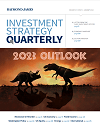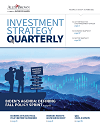Chief Economist Eugenio Alemán and Economist Giampiero Fuentes examine the factors which will contribute to the U.S. economy’s path forward in 2023.
To read the full article, see the Investment Strategy Quarterly publication linked below.
Key Takeaways:
- 2022 started on a positive note but was derailed by the Russian invasion of Ukraine which severely impacted food and energy prices globally.
- Still-strained supply chains, the large accumulation of savings during the pandemic, and a strong labor market made it impossible for inflation to come back down, triggering a very strong response from the Federal Reserve (Fed).
- The Fed is expected to continue increasing the fed funds rate until March of 2023, taking the terminal federal funds rate for this cycle to 4.75% to 5.00%.
- We expect inflation to be below 3% by the end of 2023. This will require the Fed to stay put for the whole of 2023 as inflation will not go down to the 2% target until well into 2024.
- We are forecasting a mild recession in 2023, during which we expect the economy to remain flat, and to start growing again at a rate of only 0.8% during 2024.
The current decade was dubbed by many as the ‘new Roaring ’20’s. However, as we stated in our presentation of May 2021, “It would be unlikely as there are significant psychological, demographic, and structural dynamics that suggest the unfettered elevated growth trajectory of the 1920s will not be duplicated in the upcoming decade.” In fact, in just three years the world has experienced a global pandemic, a recession, and many countries are likely to experience another recession in 2023 due to efforts by central banks to bring down inflation rates.
Although 2022 started with positive expectations of a fully reopened economy plus the view that inflation was transitory and that it would start turning the corner in the second quarter, the year was far from positive. Additionally, still-strained supply chains, the large accumulation of savings during the pandemic, and a strong labor market made it impossible for inflation to come back down. This triggered a very strong response from the Fed, which increased the federal funds rate by 425 basis points in 2022 and is expected to increase rates by a further 50 basis points until March of 2023, taking the terminal federal funds rate for this cycle to 4.75% to 5.00%. By increasing the federal funds rate, the Fed is trying to slow down the rate of growth of the economy, starting from the most interest rate-sensitive sector, investment, in the hopes of weakening the U.S. job market.
Although a federal funds rate of 4.75% to 5.00% is not very high historically, it is very high compared to what markets and investors have seen over the last several decades. Thus, the biggest problem today is that economic actors (i.e., individuals, businesses, the external sector as well as the U.S. government) are trying to adjust to these new levels of interest rates. And the way in which these economic actors adjust to higher interest rates will determine the economy’s path forward in 2023.

Higher interest rates to combat inflation
There are three primary reasons the Fed may increase the federal funds rate to levels that have the potential to trigger a recession in economic activity. Some of these reasons are found to affect the economy simultaneously and at other times, they may be independent of each other.
Currently, the Fed intends to keep interest rates higher because the U.S. economy is still growing at a rate that is higher than potential output and inflation is too high. Thus, the question for the Fed going forward is how high it will need to increase the federal funds rate and for how long to bring inflation down to its 2% rate target. Our view is that the Fed will need two years to bring inflation back down, but this process started earlier this year, so we are probably halfway to achieving low and stable prices. However, we expect inflation to be below 3% by the end of 2023. This will require the Fed to stay put for the whole of 2023 as inflation will not go down to the 2% target until well into 2024. This is the reason we are forecasting a mild recession in 2023, when we expect the economy to remain flat, and to start growing again at a rate of only 0.8% during 2024.


Read the full
Investment Strategy Quarterly
Read the full
Investment Strategy Quarterly
All expressions of opinion reflect the judgment of the Chief Investment Office, and are subject to change. This information should not be construed as a recommendation. The foregoing content is subject to change at any time without notice. Content provided herein is for informational purposes only. There is no guarantee that these statements, opinions or forecasts provided herein will prove to be correct. Past performance may not be indicative of future results. Asset allocation and diversification do not guarantee a profit nor protect against loss. The S&P 500 is an unmanaged index of 500 widely held stocks that is generally considered representative of the U.S. stock market. Keep in mind that individuals cannot invest directly in any index, and index performance does not include transaction costs or other fees, which will affect actual investment performance. Individual investor’s results will vary. Investing in small cap stocks generally involves greater risks, and therefore, may not be appropriate for every investor. International investing involves special risks, including currency fluctuations, differing financial accounting standards, and possible political and economic volatility. Investing in emerging markets can be riskier than investing in well-established foreign markets. Investing in the energy sector involves special risks, including the potential adverse effects of state and federal regulation and may not be suitable for all investors. There is an inverse relationship between interest rate movements and fixed income prices. Generally, when interest rates rise, fixed income prices fall and when interest rates fall, fixed income prices rise. If bonds are sold prior to maturity, the proceeds may be more or less than original cost. A credit rating of a security is not a recommendation to buy, sell or hold securities and may be subject to review, revisions, suspension, reduction or withdrawal at any time by the assigning rating agency. Investing in REITs can be subject to declines in the value of real estate. Economic conditions, property taxes, tax laws and interest rates all present potential risks to real estate investments. The companies engaged in business related to a specific sector are subject to fierce competition and their products and services may be subject to rapid obsolescence.
Markets & Investing Members of the Raymond James Investment Strategy Committee share their views on...
Markets & Investing Review the latest Weekly Headings by CIO Larry Adam. Key Takeaways ...
Technology & Innovation Learn about a few simple things you can do to protect your personal information...
